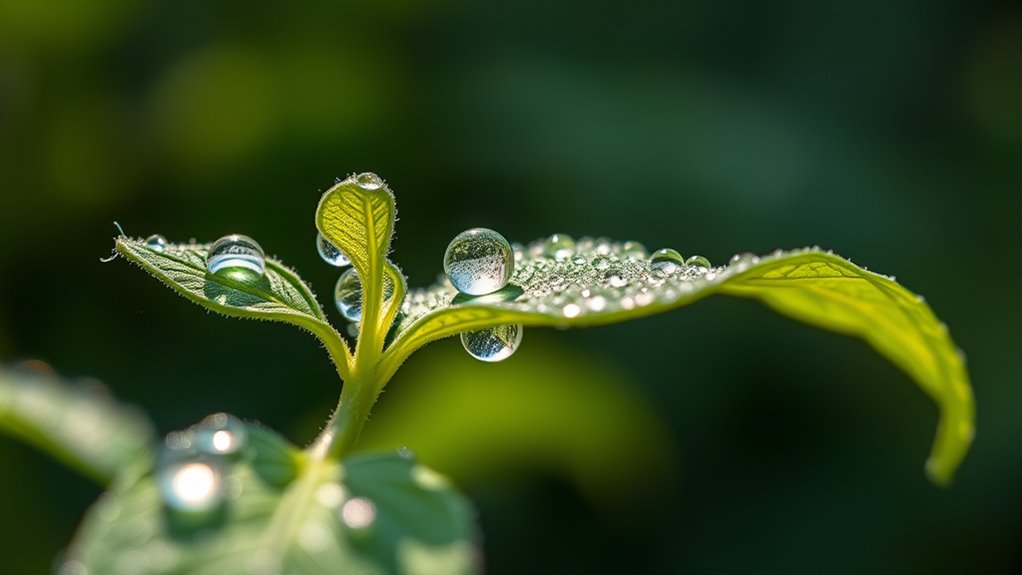Plants don’t hear sounds like animals do, but they can sense vibrations transmitted through soil or air. They respond to these vibrations by adjusting growth or activating defenses, showing a level of sensitivity that’s more complex than traditionally believed. Vibrational cues from wind, insects, or human activity can influence plant behavior, revealing a form of perception. If you’re curious about how plants interpret these signals and connect with their environment, you’ll discover more fascinating insights ahead.
Key Takeaways
- Plants detect vibrations transmitted through soil, air, or tissues, influencing their responses without “hearing” sounds like animals.
- Vibrational cues from environmental sources serve as signals for plant communication and environmental adaptation.
- Controlled vibrations can stimulate plant growth and stress resistance, suggesting sensitivity to vibrational stimuli.
- Plants respond to vibrations from insects and animals, aiding in defense and ecological interactions.
- While plants don’t hear sounds, they are sensitive to vibrational cues, indicating a form of environmental perception beyond audible sound.

Have you ever wondered how we hear sounds or how vibrations travel through different materials? It’s fascinating to think about, especially when considering the ways plants might respond to their environment. Recent studies suggest that plants are more perceptive than we once believed, capable of sensing vibrations and engaging in form of plant communication. They may not hear sounds the way animals do, but they can detect vibrations transmitted through the soil, air, or their own tissues. This vibration sensitivity could be a key factor in how plants respond to environmental stimuli, such as wind, insect activity, or even human-made noise. Some scientists are exploring the idea that plants use this ability as a form of communication, sending signals to nearby plants or adjusting their growth based on vibrational cues. This opens up intriguing possibilities for understanding plant behavior and how they adapt to their surroundings.
One area gaining attention is vibration therapy, a technique that uses controlled vibrations to influence plant growth and health. While vibration therapy is more commonly associated with humans, like physical therapy for muscles, researchers are exploring its effects on plants. They hypothesize that certain vibrations can stimulate growth, enhance resistance to stress, or even improve nutrient uptake. By applying specific vibrational frequencies, we might be able to influence plant development in beneficial ways. This concept taps into the idea that vibrations are a form of communication between plants and their environment. It’s as if plants respond positively to certain vibrational patterns, much like how humans find relaxation through music or calming sounds. These insights challenge traditional ideas of plant silence and open new avenues for sustainable agriculture and garden management.
Understanding how vibrations influence plants also ties into broader ecological interactions. For instance, plants may sense the vibrations caused by insects or animals, helping them prepare defenses or attract pollinators. This form of plant communication underscores a complex web of interactions that rely on more than just chemical signals. It makes you realize that plants, often seen as passive organisms, are actively engaged with their surroundings in subtle yet significant ways. The study of plant responses to vibrations not only deepens our understanding of plant intelligence but also hints at innovative ways to harness vibrations for agriculture or environmental monitoring. Whether through vibration therapy or simply studying how plants react to their vibrational environment, one thing is clear: vibrations are a fundamental part of how life on Earth communicates and adapts, even beneath the surface of what we can see.
Frequently Asked Questions
Do Different Plant Species Respond Differently to Sound?
Yes, different plant species respond differently to sound because their sound sensitivity varies. You’ll notice some plants, like tomatoes and beans, react more noticeably to vibrations, while others show little to no response. This variation depends on their unique structures and environments. Understanding these differences helps you explore how specific plant species might benefit from sound exposure, potentially boosting growth or health through tailored sound treatments.
Can Sound Vibrations Influence Plant Growth Over Time?
Yes, sound vibrations can influence plant growth over time. You might notice that vibrations promote plant communication by encouraging cells to send signals more effectively, which can enhance nutrient uptake and growth. Studies suggest vibration effects stimulate certain plant processes, leading to healthier development. By exposing plants to specific sound frequencies, you could potentially boost their growth, making sound an interesting tool for agriculture and plant care.
Are There Specific Frequencies That Plants Are More Responsive To?
You might be surprised to learn that plants show frequency sensitivity, responding more to certain plant auditory frequencies. Research suggests they react best to low-frequency vibrations around 100-300 Hz, which could mimic natural sounds like wind or insect activity. While not fully understood, these findings hint that specific frequencies influence plant behavior, possibly helping them adapt or grow better. Keep exploring plant auditory responses to reveal nature’s hidden communication channels.
How Do Plants Detect and Process Sound Vibrations?
You might not realize it, but plants detect and process sound vibrations through vibration mechanisms in their tissues. When vibrations occur, they trigger plant communication pathways, influencing growth and responses. You can observe this by noticing how certain sounds or vibrations affect plant behavior, suggesting that plants are sensitive to these cues. These vibration mechanisms enable plants to “sense” their environment even without ears or brains, responding adaptively to external stimuli.
Can Sound Therapy Be Used to Enhance Plant Health?
Yes, sound therapy can boost plant health. For example, a gardener uses classical music near his tomato plants, noticing faster growth and fewer pests. The vibrations from sound therapy stimulate plant cells, improving nutrient absorption and resilience. While scientific evidence varies, many believe that sound therapy positively influences plant health by encouraging stronger, healthier growth. So, if you want healthier plants, try incorporating soothing sounds into your gardening routine.
Conclusion
So, it seems no coincidence that plants might respond to sound and vibrations—nature’s subtle signals woven into their existence. As you observe these quiet interactions, you begin to wonder if, perhaps, plants truly can hear in their own silent way. The more you explore, the more you realize that what we perceive as coincidence may just be nature’s intricate language, waiting to be understood. In this dance of sound and silence, the line between chance and communication blurs beautifully.










